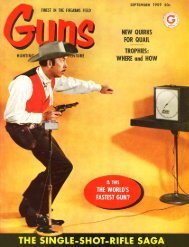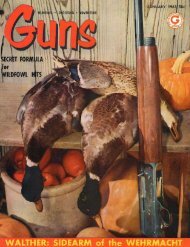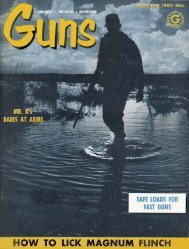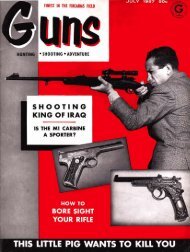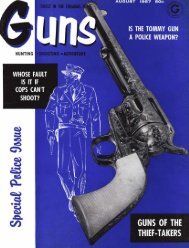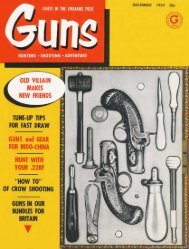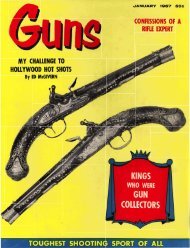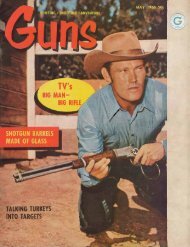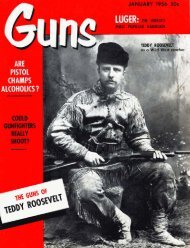Create successful ePaper yourself
Turn your PDF publications into a flip-book with our unique Google optimized e-Paper software.
Heavy 1/^" steel plate fired at in tests reveals comparative power of U.S. .45 cartridge and German service bullet.<br />
call it an old fiend. The .45 actually<br />
has more stopping power than smaller<br />
calibers, which is the main argument<br />
put up by supporters. But that doesn't<br />
mean it has much, if any more killing<br />
power. If the argument of stopping<br />
power would hold water as well as a<br />
shotgunned Stetson hat, why not re-<br />
place the .30/06 rifle with the .600<br />
Nitro Express? As a matter of fact, we<br />
are going to have an even lighter rifle<br />
and cartridge, and for very good rea-<br />
sons, that also should apply to the<br />
pistol.<br />
Much has been written about com-<br />
parative tests between the .45 and the<br />
9mm Luger load. Any user of the<br />
Luger knows that the gun is subject to<br />
malfunctions of one kind or another<br />
which can be traced directly to the<br />
weak American ammo of low power as<br />
loaded by Winchester and Remington<br />
commercially. Although glorified by<br />
"Super-X" or other high speed trade<br />
names, the U.S. cartridges are inferior<br />
to the European loads.<br />
To settle in my own mind the dif-<br />
ferences between the .45 and 9mm, I<br />
ran some penetration tests for <strong>GUNS</strong>.<br />
We don't have much ice down here in<br />
Texas, but wood and steel were used.<br />
Five 1" x 6" boards 25 inches long<br />
were nailed together to make test<br />
blocks. Bullets were fired into the cen-<br />
ter board from 12 inches away.<br />
A Luger and a Smith & Wesson 1917<br />
.45 were used for this test. The block<br />
was reversed so that it could be used<br />
German service 9mm bullet shed its jacket (left) in penetrating l/C steel plate<br />
but .45 slug burst jacket, flattened out and stopped -cold (right) on steel.<br />
18<br />
to test both calibers in the same wood.<br />
The bullet channels were cut open<br />
when the blocks were disassembled.<br />
Ammo I used included the hot Ger-<br />
man 9mm load, a 124 grain bullet ai<br />
about 1300 feet per second in a 12"<br />
barrel. The exact figure in my shorter<br />
Luger barrel I don't know. The G.F.L.<br />
38 cartridges, used in Italian subma-<br />
chine guns and loaded by Fiocchi, also<br />
used in my tests, developed 1250 f.p.s.<br />
in a 6" barrel, according to the Fiocchi<br />
factory records. It gained this velocity<br />
with a 115 grain bullet developing<br />
slightly more than 25,000 pounds per<br />
square inch pressure.<br />
The heavy German bullet pene-<br />
trated Sy^," of pine. Contrasting, the<br />
.45 fired in the 5 q S & W revolver<br />
barrel which maintains velocity equal<br />
to or greater than the auto pistol's<br />
short barrel, penetrated only 4%" in<br />
the same board. No expansion of the<br />
jacketed bullets was noticed in either<br />
caliber.<br />
On Vyr' steel plates, the difference in<br />
penetration was significant. The 9mm<br />
went through (from 12 feet distant) ;<br />
the .45 didn't. Even on a curved plate<br />
at an angle, the .45 ricocheted doing<br />
little damage, while the old Western<br />
truncated cone bullet made a huge<br />
dent.<br />
I cross checked my results with Val<br />
Forgett, formerly of Aberdeen Proving<br />
Ground and now a hot-temperec





